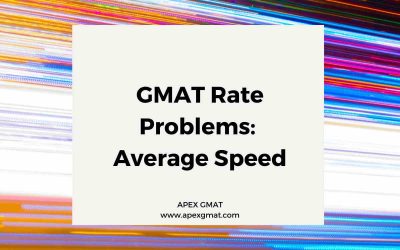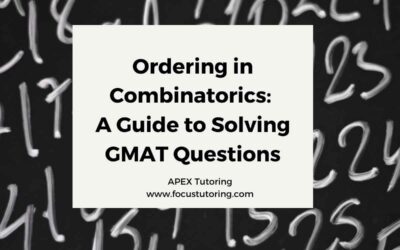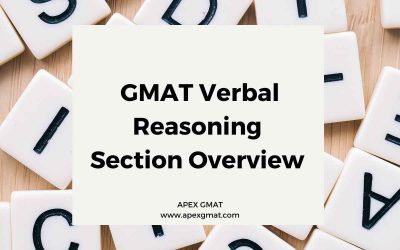Blog
Top Posts
Pieces of Pi: Sectors, Arcs, and Central Angles
Welcome back to our series on GMAT circles. In the first article, we introduced the properties of radius/diameter, circumference, and area, discussing the relationships between all of these. This time we will introduce something called a central angle, which creates...
GMAT Rate Problems: Average Speed
Welcome back to our series on GMAT quant rate problems. This article and the next will introduce concepts related to average speed. Though average speed is a simple concept, there are many ways for GMAT quant problems to “trick” test-takers with average speed...
Does Your GMAT Score Belong On Your Resume?
For business school candidates and career-focused professionals, acing the GMAT can feel like a significant milestone. But once you’ve completed the test and received your score, the question arises: Should you include your GMAT score on your resume? The answer...
All Our Posts
Taking the GMAT Exam in Tel Aviv
Table of Contents: Who administers the GMAT test? What does the test center look like? Where are the test centers located? Test center holidays Top MBA programs in the area Tips Test Day FAQs About ¾ of the way through your extensive GMAT prep you should begin to...
Taking the GMAT Exam in Dublin
Table of Contents: Who administers the GMAT test? What does the test center look like? Where are the test centers located? Test center holidays Top MBA programs in the area Tips Test Day FAQs About ¾ of the way through your extensive GMAT prep you should begin to...
Taking the GMAT Exam in Dubai
Table of Contents: Who administers the GMAT test? What does the test center look like? Where are the test centers located? Test center holidays Top MBA programs in the area Tips Test Day FAQs About ¾ of the way through your extensive GMAT prep you should begin to...
Taking the GMAT Exam in Miami
Table of Contents: Who administers the GMAT test? Where are the test centers located? Top MBA programs in the area Test Day FAQs About ¾ of the way through your extensive GMAT prep you should begin to start planning your test day, including scheduling the test,...
How to Choose the Best GMAT Tutor
Selecting the right GMAT tutor can be a game-changer for your test preparation journey. For many people considering a tutor, the expectation is someone who can provide content-level knowledge and show you how to do problems that challenge you. An expert tutor,...
12 Schools That Offer MBA Programs In Luxury
As the world of MBAs continues to evolve every day, programs continue to offer broader opportunities making ever more career choices attainable. The idea of expanding horizons gives prospective MBAers a place to become creative and innovative. Applying to top MBA...
Top MBA Programs In Switzerland
MBA Programs on Offer in Switzerland University of St. Gallen The University of St. Gallen is one of the most prestigious Swiss business schools with globally recognized MBA programs. The university offers MBA programs in Business Innovation, Marketing Management,...
Top MBA Programs in Hong Kong
MBA Programs in Hong Kong Hong Kong University of Science and Technology Business School (HKUST) HKUST was founded in 1991 and offers a top-tier MBA program. It defines itself using its unique East-West education ethos and is the leading Business School in the region....
Top MBA Programs In Dubai
For those who are seeking to live and study in the world’s fastest developing business hub, Dubai is a great choice. With several internationally accredited MBA programs in Dubai, which attracts students and professionals from across the world, with the numbers...
Top MBA Programs in Singapore
A young but very innovation-oriented and wealthy country, Singapore is an exceptional destination for your MBA studies. Located in Southeast Asia, Singapore is home to numerous well-known business schools that offer both MBA programs, including full-time and part-time...
GMAT Focus Edition: Your Questions Answered
How is the new GMAT Focus Edition different from the current version? The GMAT Focus Edition is shorter and has a smaller syllabus than the current version. The GMAT Focus Edition will have no Analytical Writing Assessment. The current version’s quant section gives 62...
Taking the GMAT Exam in Berlin
Table of Contents: Who administers the GMAT test? What does the test center look like? Where are the test centers located? Test center holidays Top MBA programs in the area Tips Test Day FAQs About ¾ of the way through your extensive GMAT prep you should begin to...
How to Boost Your GMAT Verbal Score
The GMAT is notorious for its grueling quantitative section, but many test takers also struggle with the verbal section--especially non-native English speakers. A high verbal score will boost your overall score and enhance your critical thinking skills, bringing you...
GMAT Focus Edition Practice Exam: Expert’s Analysis
The GMAT Focus Edition is on its way. With the release earlier this week of the 2023-2024 Official Guide and its accompanying review books, digital practice question packs for each of the test’s three sections, and, of course, the first two official practice exams,...
GRE Analytical Writing: A Step-by-Step Guide
Before you begin your battery of Quantitative Reasoning and Verbal Reasoning sections on the GRE, you will have to complete the Analytical Writing measure. Read on to learn about this important section of the test and for useful preparation tips. What is the...
How to Build a Strong GRE Vocabulary That Will Last
By now you know that GRE preparation, for almost everyone, involves studying vocabulary words. Half of the questions on the GRE verbal reasoning sections are vocabulary-based. You will have to select from an answer choice set of vocabulary words to appropriately fill...
Ordering in Combinatorics: A Guide to Solving GMAT Questions
What is an Ordering Task? Ordering tasks are a common type of question on the GMAT. In an ordering task, you are asked to determine the number of ways to order a set of objects. The number of ways to order n different objects is n!, or n factorial. The best way to...
Text Completion and Sentence Equivalence on the GRE
Vocabulary-based questions on the GRE verbal reasoning sections are of two kinds: text completion and sentence equivalence. Both types are about filling in blanks in sentences with the right words based on context, but the answer choice formats are different. In this...
Anatomy of GRE Verbal Reasoning Section
There are only three types of questions on a GRE verbal reasoning section: text completion, sentence equivalence, and reading comprehension. (Text completion and sentence equivalence are quite similar, as discussed in our last article.) Feel at home on the verbal...
How to Ace the GMAT Verbal Section
It’s not secret that business schools look for high GMAT scores. What you might not know is that the Verbal section on the GMAT has an outsized influence on the aggregate score. This means that the path to a truly great score, once you’ve hit the minimum marks on the...
Comprehensive GMAT Preparation
Step 1 – Complimentary Consultation
Step 2 – Assessment & Written Report
Step 3 – Work with a top scoring Apex trained instructor on your personalized prep plan.
Step 4 – Success
View our client success stories and find out how we position our clients to achieve and why we are the best choice for your success.
Book a Meeting Today!
Schedule a complimentary consultation call with one of our Instructors for Success with Apex . Act now as others have already done.





















